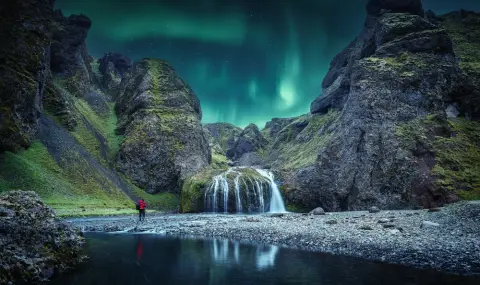The Seljalandsfoss waterfall is one of the most popular destinations in Iceland - hundreds of tourists park their rented cars and campers in a small parking lot near the waterfall. Long lines form, lined up with people with cameras and tripods. This place used to be relatively unpopular, writes ARD. But nowadays many draw inspiration for tourist destinations from social networks.
In search of the perfect photo
If you type "Iceland" into any search engine on the Internet, you will be overwhelmed by countless beautiful photos and videos. They are also becoming more and more on social networks. And over time, the photos have become more and more provocative - people pose in front of an erupting volcano behind them or hanging high in an ice cave, clutching an axe stuck in the ice. However, one thing is the same in all the photos - the tourists pose all alone in front of breathtaking views. But is this true?
Influencer Gunnar Freir Gunnarsson shows on his social media channels how he tours beautiful nature - rivers, waterfalls, ice landscapes. "I try to show my Instagram audience something new", he tells German public broadcaster ARD. "Something they haven't seen before." And to do this, he goes to places no one else has been. Anyone who sees his photos immediately feels the urge to pack their bags and go visit the beautiful locations.
Competition among influencers too
However, there is also a lot of criticism of this practice. Under one of Gunnarsson's videos, a user writes: "Soon 40,000 people will come and create a traffic jam because of your video". Gunnarsson himself grew up in Iceland and respects nature and the rules there, the German public-law media outlet reports.
Nevertheless, he wants to be popular on social networks. And to do that, he has to fight for his audience. There is serious competition among influencers, he says. "That's why there's always pressure to find something new, something that can go viral. "It's sometimes exhausting," the man says.
The important role of tourism
When the Eyjafjallajökull volcano erupted in 2010, the cloud of volcanic ash stopped air traffic in Europe and tourists began to avoid Iceland. With interesting campaigns on social networks, the country managed to regain its good image as a tourist destination. Tourism is a very important industry for Iceland.
Lilja Alfredsdottir was Minister of Economy until the end of last year. She was also responsible for tourism. If it were up to her, the number of tourists would only increase, she says. "Tourism brings about 9% of the gross domestic product. We export energy, fishing is also important. But tourism is the most important economic factor. "He was the one who got us back on our feet after our economic collapse," explains Alfredsdottir.
The former minister spoke about the collapse of the banks - Iceland practically went bankrupt in 2008, when the three largest banks collapsed within just a few days. At that time, tourism saved the country's economy.
Concerns about environmental damage
However, Elizabeth Sveinsdottir from the Environment Agency looks at tourism differently. According to her, sometimes influencers do not send the best messages to the world. "They make a region famous very quickly. But it cannot handle so many people. They only come for a few selfies, but they destroy the nature. Everything happens very quickly," Sveinsdottir commented to ARD.
Iceland's nature is extremely beautiful, but also vulnerable, explains the expert. Tire tracks, for example, remain in the forest moss for years because the cold climate means everything grows very slowly. "This is crossing all boundaries. We can't keep up with the infrastructure to regulate the influx of tourists. It's just unreal."
Author: Christian Blenker (ARD)
